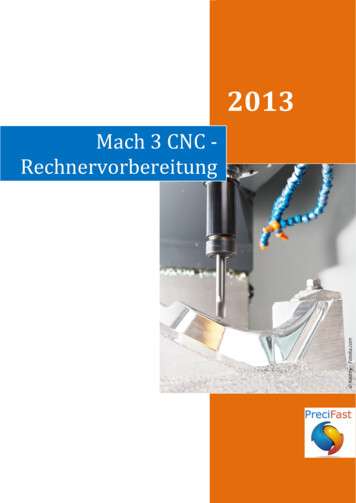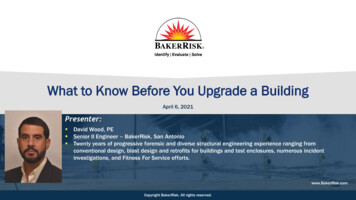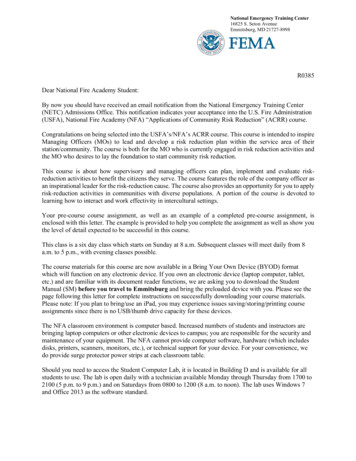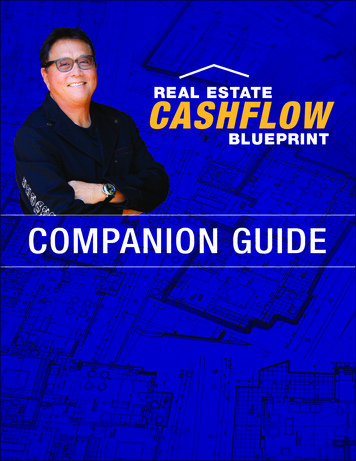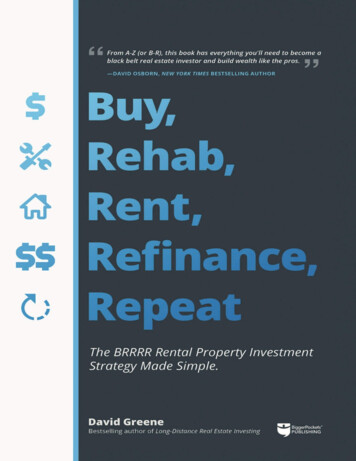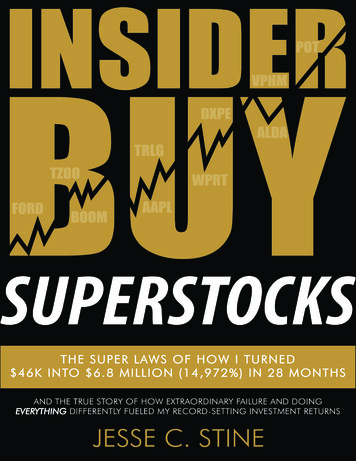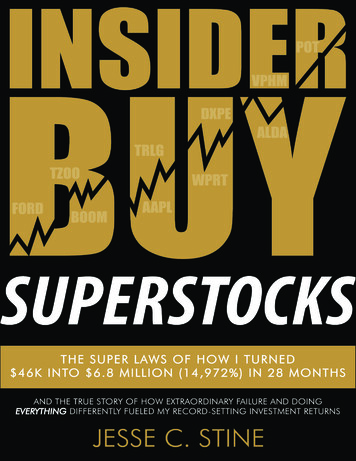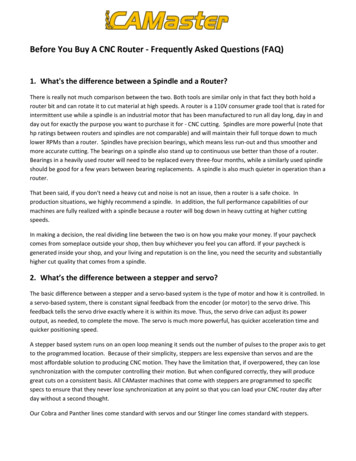
Transcription
Before You Buy A CNC Router - Frequently Asked Questions (FAQ)1. What's the difference between a Spindle and a Router?There is really not much comparison between the two. Both tools are similar only in that fact they both hold arouter bit and can rotate it to cut material at high speeds. A router is a 110V consumer grade tool that is rated forintermittent use while a spindle is an industrial motor that has been manufactured to run all day long, day in andday out for exactly the purpose you want to purchase it for - CNC cutting. Spindles are more powerful (note thathp ratings between routers and spindles are not comparable) and will maintain their full torque down to muchlower RPMs than a router. Spindles have precision bearings, which means less run-out and thus smoother andmore accurate cutting. The bearings on a spindle also stand up to continuous use better than those of a router.Bearings in a heavily used router will need to be replaced every three-four months, while a similarly used spindleshould be good for a few years between bearing replacements. A spindle is also much quieter in operation than arouter.That been said, if you don't need a heavy cut and noise is not an issue, then a router is a safe choice. Inproduction situations, we highly recommend a spindle. In addition, the full performance capabilities of ourmachines are fully realized with a spindle because a router will bog down in heavy cutting at higher cuttingspeeds.In making a decision, the real dividing line between the two is on how you make your money. If your paycheckcomes from someplace outside your shop, then buy whichever you feel you can afford. If your paycheck isgenerated inside your shop, and your living and reputation is on the line, you need the security and substantiallyhigher cut quality that comes from a spindle.2. What’s the difference between a stepper and servo?The basic difference between a stepper and a servo-based system is the type of motor and how it is controlled. Ina servo-based system, there is constant signal feedback from the encoder (or motor) to the servo drive. Thisfeedback tells the servo drive exactly where it is within its move. Thus, the servo drive can adjust its poweroutput, as needed, to complete the move. The servo is much more powerful, has quicker acceleration time andquicker positioning speed.A stepper based system runs on an open loop meaning it sends out the number of pulses to the proper axis to getto the programmed location. Because of their simplicity, steppers are less expensive than servos and are themost affordable solution to producing CNC motion. They have the limitation that, if overpowered, they can losesynchronization with the computer controlling their motion. But when configured correctly, they will producegreat cuts on a consistent basis. All CAMaster machines that come with steppers are programmed to specificspecs to ensure that they never lose synchronization at any point so that you can load your CNC router day afterday without a second thought.Our Cobra and Panther lines come standard with servos and our Stinger line comes standard with steppers.
3. What’s better, rack-and-pinion or ball screw?The short answer is that both are good based on which is best-suited for a particular axis or application. Each hasits pluses and minuses. CAMaster uses both systems on all of our machines.Ball screws are best known for being smooth and friction-free. Over a long axis however, a ball screw-drivensystem is susceptible to “screw whip”, which is vibration that worsens the faster a screw rotates. This is becauseof the critical speed of rotation needed over a long axis. To alleviate this, a ball screw driven system requires moregearing or larger motors to compensate for the weight and need to maintain the rapid positioning speeds. Thismakes the use of a ball screw on an axis over 4’ in length unsuitable. That being said, for shorter lengths, this israrely realized which makes the use of a ball screw a good choice for the short axis. CAMaster machines comeswith a ball screw on the Z axis - our short axis.Rack-and-pinion drives are best known for being rigid and not limited by length which makes them ideally suitedfor the long axis. When mounted properly, they provide years of use with minimal wear and are virtuallyimpervious to dust and debris. A rack-and-pinion drive is geared more aggressively to better utilize the torque ofthe motors providing an appreciable difference in speed between the two systems. Rack-and-pinion’sshortcomings include higher friction and potential backlash if the pinion is not properly engaged. At CAMaster, weuse the Self Adjusting Pinion Engagement Drive System that delivers zero backlash and positional accuracy of .002″ throughout the entire travel distance of the machine. CAMaster machines comes with rack-and-pinion onboth the X axis and the Y axis - our long axes.Perhaps the best way to impress on you the rack-and-pinion vs. ball screw question is to look at CNC machinescosting 100,000 to 300,000. You’ll notice that most of these machines use both rack-and-pinion and ball screwon the same machine - just like CAMaster. In summary, rack-and-pinion is best for a long axis - it will be faster andwill alleviate trouble with whip and vibration. For the short axis, ball screw is best.4. What size machine is best for me?This is one of the biggest questions you will ask yourself while looking at purchasing a CNC router. You want allyou can get without breaking the bank and without having to remove a wall. What kind of work do you want to donow? How about 3 years from now? If you are in a small shop and you only want to make small parts, a smallmachine will likely do you just fine. But if you want to cut full sheets you will do well to look at a 4'x8' or largermachine. You will be hurting yourself if you plan on getting by with a smaller machine and just pull your materialthrough. It may be fine in the beginning but when you get a few jobs, pulling sheets of material through a CNC willbe extremely time consuming and as a result expensive.Buy your second machine first. This is a statement you may have heard or read when it comes to CNC machines.This is not a marketing ploy. It is a very important piece of advice to those new to CNC that may not see the bigpicture yet. Buying a basic CNC is great for hobby use. But when it comes to a shop that wants to use a machine inproduction, even light production, this can be a huge set back.5. How fast will my machine go? How fast can it cut my parts?The speeds vary depending on which model. Each model's speeds and accuracy are published on our website.However, your cutting speed (feed rate) will depend upon various factors, including:
Machine set-up —Variables that affect every machining application are spindle horsepower, rigidity and runout,collet condition, hold down system and tool sharpness.Number of flutes — Single-flute tools should generally be fed at a slightly higher rate (approximately 10%) thandouble-flute tools.Bit diameter — A 3/8″ bit can be fed 10% faster than a 1/4″ bit. A 1/2″ bit can be fed 20% faster than a 1/4″ bit.Depth of cut — Your feed rate should be decreased approximately 25% for each multiple of the depth of cut. (Ifdepth is two times, reduce by 25%; if depth is three times, reduce by 50%.)Spindle speed — The faster the RPM of your spindle, the quicker you can cut your parts.Tooling catalogs will typically provide CNC machining feed charts as a reference tool. When buying tools, theseguides can prove to be an invaluable resource. US Router Tools, Inc. is our preferred tooling provider. They offer a10% discount on tooling purchases to CAMaster customers as well as free shipping. (Minimum order applies. Askfor details.). You can find them at http://www.usroutertools.com6. Do I need to learn a programming language like G Code to operate a CNC router?No, you don't. The design software titles available today allow you to design your files, import pictures anddrawings, manipulate them and the software will in turn generate the code that the machine will use to cut outyou parts.WinCNC, the motion control software we use, is based on standard G-codes. The G-codes provide a source codecomprised of inches/mm and axis movements, which can be edited and understood by others. It is a good ideaafter you get more accustomed to your CNC to learn some simple lines of code just so it can help you look forerrors, but it is by no means necessary.7. What software do I need?This all depends on what you want to do with your CNC router. Each type of work has more than one softwaretitle that will work for you. It is important to understand what it is you want to do and what machining methodsyou will need in order to produce your work. The reason being that when it comes to software, there is asignificant difference in both features and price on the multiple software titles out there. Depending on what typeof work you are doing, you may be able to get a simple low or mid-range title that will do everything you need.If you plan on making V Carved Signs or 2D parts Vectric's V Carve Pro is as good a program. This title comesstandard on all CAMaster CNC Routers with exception to the Stinger I which comes with Vectric's Cut 2D Pro. Thistitle even has great manufacturing tools such as nesting, tabbing, engraving and lots more.If 3D (2.5D) is what you are looking for, Vectric's Aspire software is a good choice. Aspire is laid out just like VCarve Pro but offers a modeling package with standard tools for producing top quality 3D artwork. Vectric offersan upgrade path from VCarve Pro to Aspire.These options from Vectric a great fit for 90% of non-production users.Other software options with more robust tools and features are Enroute and ArtCAM.
For cabinet makers, there are a number of offerings to choose from. One that stands out for the small 1-3 manshops is Mozaik. It is a pay by month title that offers a lot of the capabilities that the larger more expensivepackages have, though not all. One place that it lacks is in its rendering feature for cabinets and rooms forsubmittals which is limited. If you need a more streamlined and feature rich software, KCD Software is a greatoption. Another option is Cabinet Vision.Can I use AutoCAD? Yes, AutoCAD drawings can be imported into most software design packages as a dxf. Thismakes it simple if your shop is already using CAD drawings. This will keep you from having to redo all the work youalready have invested time into. WinCNC, the motion control software, can also import a dxf and run directly fromyour CAD file. This is not recommended as you will have to know the tool offsets. It is always better to bring thesedrawings into your CAD/CAM software to produce the code. This gives you more control as well as a visual aid.8. What HP spindle do I need?The type and thickness of your material, the type of tooling you’re using and the nature of your parts willdetermine what type of spindle you need. CAMaster is more than happy to assist you in determining the idealspindle for your needs.9. How do I hold down my material?The size of your part, type of material and production goals will determine the most-suitable method of holdingyour material in place. Generally, a vacuum system is the most-efficient method of holding down your material.You can also mechanically fixture your material with clamps, screws or double-stick tape or use a jig system.10.Do I need a vacuum hold down system?A vacuum system is a great addition to any machine. If used correctly a vacuum system can save you time andproduce a clean cut edge even on hard to cut material like melamine and acrylic. If you are in a production setting,a vacuum system is a must. It will pay for itself.no questions asked.CAMaster offers many different vacuum systems to fill a wide range of customer needs. From single phase lightduty systems to industrial heavy duty systems with either a regenerative blower or vane pump.11.What machine is right for me? Stinger, Panther, Cobra. Oh My!Getting a machine that will serve you now and will allow you room to grow should be your number one goal.CAMaster offers 5 different lines of CNC routers. This ensures that our customers are able to get the exact CNCthat they need for their shop and one that's within their budget. All CAMaster machines are proudly built here inthe USA at our facility in Cartersville, Georgia - an hour north of Atlanta.All CAMaster machines are built with a heavy welded industrial steel frame and comes standard with a control PC,WinCNC control software and design software paired with our lifetime tech support.Our lines are as follows:Stinger I – The Stinger I is our bench top model of CNC router. With its small footprint it can fit in any shop layout.Built in the same style as our larger more industrial routers the Stinger I is without a doubt the most robust benchtop CNC router on the market. The work envelope for the Stinger I is 25"x36"
Stinger II – The Stinger II is the most versatile entry level CNC on the market. The Stinger II comes in two sizes tofit your needs. A 3' x 4' and a 4' x 4'Stinger III – The Stinger III comes in a 4x 8 size and is perfect for the small shop that wants to cut full sheets ofmaterial. The Stinger III has a work envelope of 49" x 97".Panther – The Panther is a full production machine and by far the best bang for the buck on the market. It comesin two sizes. A 4'x8' and a 5'x8'. The Panther comes standard with a brushless servo system and canaccommodate up to a 5 HP spindle as well as a 5 HP ATC spindle complete with a 6 or 8 tool rotary carousel. It isperfect for a 1 - 5 man shop that needs a robust and reliable cutting machine.Cobra – The Cobra line is our flagship and a true workhouse. The Cobra comes in multiple sizes from a 4'x4' to a6'x 20' . The Cobra is our toughest, most sophisticated CNC router with enough production capability for a twoshift factory. The Cobra uses advanced servo driven technology and can accommodate up to a 13 HP spindle Someof the options available on the Cobra are ATC, Drill Bank, Aggregate Heads, Knives, Extended Gantry up to 24"High, Multiple Spindles, Optical Eye Registration System, Fully Automatic Vacuum Zones and many more.12.What kind of support do you offer?CAMaster provides lifetime support on all of our machines. Our support technicians are available by phone,internet or at your facility. (Some fees may apply.) Additionally, each machine is pre-configured for remotedesktop support. This enables our technicians to troubleshoot your CNC via an internet connection no matterwhere you are located.13.Do you offer training?CAMaster personnel can assist you with training in the use of software and/or machine operation, depending onyour needs. Training can be done either at the customer’s location, at CAMaster’s facility or Online.14.Do you offer financing/leasing?CAMaster, in partnership with Susquehanna Commercial Finance, has made it simple and convenient for ourcustomers to finance/lease their machine purchase. (Click here for a free quote.) You can also use your ownleasing company, if you choose. Financing/Leasing a CNC machine brings with it many advantages, including taxbenefits and minimal, sometimes zero, up-front cash requirements.15.What type of warranty do you provide?CAMaster warrants every machine we manufacture against defects in workmanship, materials and constructionwhen used under normal operating conditions and in accordance with provided specifications for a period of one(1) year from the date of delivery for the Panther and Stinger models and an industry best two (2) years for Cobramodel.16.Why Buy a CAMaster?At CAMaster, we are guided by one principal - make each CAMaster Router the most industrial and rigid CNCmachine in its class. Click here to learn more about the Technology, Quality and Support that goes into eachCAMaster machine.
6. Do I need to learn a programming language like G Code to operate a CNC router? No, you don't. The design software titles available today allow you to design your files, import pictures and drawings, manipulate them and the software will
